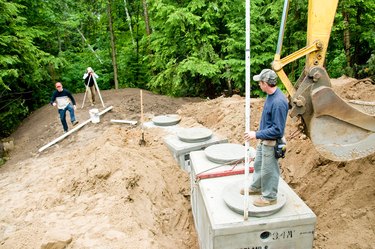
Depending on the geographical characteristics surrounding the settlement, apartment buildings can use conventional and alternative septic system types. These can range from systems that process wastewater more efficiently to models that work effectively in areas with minimum layers of soil. These diverse configurations are excellent for treatment of effluent in populated areas too far from public sewage systems found within urban areas.
Conventional Septic Tank Systems
Video of the Day
Basic and pressure distribution septic systems are two conventional system configurations. The basic system has been the standard for years. It relies on gravity to cycle wastewater until it reaches the drainfield. The pressure distribution model, however, is now considered more efficient, because it distributes wastewater throughout the different areas of the drainfield simultaneously. Thus, you can find pressure distribution methods in many of the newer septic tank systems.
Video of the Day
Gravity and Pressure Distribution Systems at Work
When using a basic, gravity-type septic system, all the water you use in your kitchen, bathroom and laundry room goes into a septic tank outside your apartment building. Heavy solids settle at the bottom of the tank. Bacteria inside the tank turn some of this waste into a digested viscous matter and gas, which is routed to a drainfield near the tank for treatment and recycling into deeper groundwater pockets. In this model, the tank should be serviced every few years to pump out the waste that has not decomposed. A pressure distribution system works in a similar way, except a pump is used to evenly distribute decomposed wastewater across the drainfield.
Alternative Systems
Unfortunately, gravity and pressure distribution systems are not a good choice for all geographical areas. In this case, alternative methods such as aerobic treatment and mound and sand filter systems may be used in place. An aerobic treatment unit uses oxygen to decompose solid waste in the septic tank more efficiently. Mound systems are suitable for areas where apartment buildings have little or insufficient soil for wastewater treatment. A sand filter system is similar to a mound system but incorporates a sand filter and pump.
How Alternative Systems Work
The most common aerobic treatment systems use a suspended growth process where oxygen is injected into the septic tank to help bacteria grow and act on wastewater solids. The mound system works in a way similar to a conventional one. However, it incorporates a pump and a small hill above ground level that provides a primary filtering process. This gives the water an extra level of filtering before it reaches groundwater. Sand filter systems integrate an extra sand-filled area that works as a primary filter for wastewater pumped out of the septic tanks before it reaches the drainfield and, subsequently, the groundwater.
Other Types of Septic Systems for Apartments
Although several methods have been implemented and used in the past, some private companies have developed their own proprietary systems. Mainly, the filtration process is what differentiates these new septic treatment processes. The Glendon® BioFilter, for example, uses layers of sand to filter decomposed wastewater upward through a drainfield and into the soil. The AdvanTex Filter uses engineered textile fabric to treat a great amount of wastewater in a shorter space than conventional systems. The Drip Irrigation model uses a shallow pressure system to distribute preprocessed wastewater at a slow rate, where drainfield saturation may pose a risk.